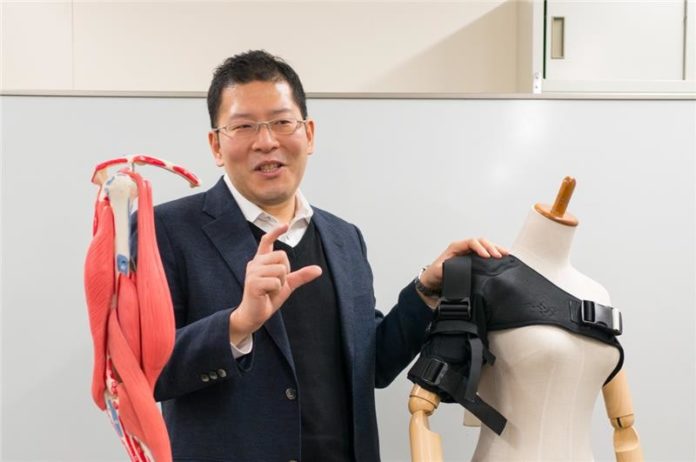
A prototype for wearable equipment to support human motion has been developed at Hiroshima University, Japan. This wearable equipment, called the Sensorimotor Enhancing Suit (SEnS), enhances sensorimotor functions by reducing the muscle load of the upper limbs. SEnS is inexpensive because it is made of flexible fabrics using regular cloth and does not include any electronic devices. SEnS assists human sensorimotor functions and improves the quality of life of not only elderly individuals but also healthy people who work under extreme conditions.
Recent advances in assistive technologies have provided technical aids to augment athletes’ muscle strength or to rehabilitate disabled individuals. To support human motions in a safe and acceptable manner, knowledge of the human musculoskeletal dynamics and three-dimensional models of human sensation and motion are helpful for performing subjective evaluations and realizing an intuitive, safe, and easy-to-use design. However, it is difficult to wear and remove typical assist devices quickly because they contain heavy electronic motors and pneumatic actuators. It is also expensive to maintain an assist device.
Associate Professor Yuichi Kurita at the Institute of Engineering at Hiroshima University and his collaborators including Hokkaido University, Smart Support Technologies Inc., and Georgia Institute of Technology have demonstrated that humans can sense the intensity of external stimulus more accurately when the voluntary muscle activity is less. This research group also investigated how differences in voluntary muscle activation affect the force perception capability of humans. Based on these research results, Dr. Kurita and his collaborators developed SEnS, a muscle assistive equipment that reduces the load on one’s upper limb. Then, they evaluated the improvement in the sensorimotor capability when voluntary muscle activation is reduced using SEnS.
Dr. Kurita said that “Human muscular movement is well-known anatomically and physiologically. However, understandings of how to compute human musculoskeletal dynamics and build models of human sensation and motion using a computer are very limited. Furthermore, it is rare to develop products using a model that is computable in this research field. We calculated the movement of the human muscle using a computer and measured the maximum point of human sensorimotor function. SEnS is designed to improve sensorimotor performance during use. In the future, we can develop made-to-order SEnS in keeping with individual muscle movements using our technique.”
Story Source:
The above story is based on materials provided by Hiroshima University. Note: Materials may be edited for content and length.
Journal Reference:
- Yuichi Kurita, Jumpei Sato, Takayuki Tanaka, Minoru Shinohara, Toshio Tsuji. Unloading muscle activation enhances force perception. 5th Augmented Human International Conference, 2015 DOI: 10.1145/2582051.2582055
